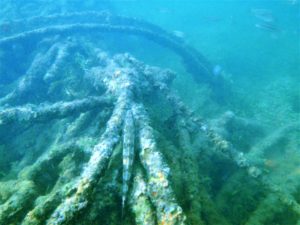In addition to my recent discovery of an Oyster Blenny at the Ship’s Graveyard in the North Arm of the Port River, I also found this bivalve mollusc shell there.
I checked it out further when I got home. I thought that it was a Venus shell, Tapes literatus. I photographed it with my mobile phone at home and sent the photo to Peter Hunt from the Malacological Society of SA for a positive ID. Peter’s response was as follows: –
“Thank you, Steve, for bringing this Port River find to my attention. This is a bigger and better specimen, and is the same species as the one I had spotted and collected a few months ago. There is a report from SARDI that they have found it too, but to my knowledge no specimens have reached SAM to date. Definitely the common and wide spread tropical species Veneridae Tapes literatus. Other more southern species names are often (cited) as present in Southern Ports and NZ as pests.
Note: some of these are now synonyms. Well done! Let’s find the living colony now.”
Society member Lyndon Zimmermann asked for more details from Peter, who responded: –
“Thanks for your interest in this one. At this point the only relevance of this Venus specimen is that it is definitely not a South Australian species and therefore has, by methods unknown, been introduced into the Port River. At least three specimens have now been reported, two recently and one several years ago. The two recent specimens were dead but both found as pairs of valves still joined by a relatively light ligament indicating to me they had arrived at their discovery point recently deceased. They may have been introduced as bait (discarded empty shells) by fishermen. This species, I believe, has been sold for food elsewhere in Australia and OS. Not in SA as far as I can tell. It would not be the first time an imported food species has been used for cheap bait. (In which case, this act has illegally introduced (the) shell into our waters). The other most likely reality is that numbers unknown have started to colonize the Port River. The level of invasiveness is still unknown to us. If a colony does exist I expect that a colony will only be competing for a limited habitat space at this point (with displacement of other sand dwelling bivalves likely). Other implications of their existence should be researched earlier rather than later, more hastily if we can confirm a population existence with more finds. If my ID is confirmed, then this common species and other similar species are all well documented and can easily be researched.”
Thierry Laperousaz, the Collection Manager for Marine Invertebrates at the Science Centre at the South Australian Museum asked for the specimen shell for the Museum’s shell collection. Society member Dan Monceaux suggested that “tropical species in the Barker Inlet would likely increase in number closer to the warm water discharges of the power station, though the plant’s sporadic operation may be reducing the range of these animals in recent years as demand for gas-fired power has reduced.”
I also photographed another unusual fish during my snorkel at the Ship’s Graveyard that same day. The fish did not move despite me approaching it from all directions and taking photographs of it.
My first thought was that it looked like a Congolli. When I asked Mark McGrouther at the Australian National Museum for help identifying it, he asked me to post my photos of the fish online via iNaturalist.org. This started a string of messages about the photos, as follows: –
“Thank you for adding the images Steve. The fish looks quite odd. Very slender and it looks as though it has ‘eyebrow ridges’.” Two other people were asked for their thoughts. Both of them thought that it was a Congolli (Pseudaphritis urvillii) and Mark seemed to agree with them.
David Muirhead and I were not convinced at all, thinking that it may have been a Krefft’s Goby. “What about the photo (of a Krefft’s Goby) at http://www.inaturalist.org/observations/5134374 ?” I asked.
One response received back was, “Nope. Wrong proportions and head shape. 😉 Gobies have blunter head and lack the ridges on the side of the body.” I responded with, “Thanks, I don’t have your skills of observation in these matters. So, it’s Congolli then?” The response received back was “Yep, lovely shot too, only the second observation of this species so far and the other one was of an individual in a net!” (See the web page at http://www.inaturalist.org/taxa/498780-Pseudaphritis-urvillii .)
According to that web page, “Pseudaphritis urvillii is the only species of fish in the family Pseudaphritidae and the genus Pseudaphritis. It is known also as the catadromous icefish, the tupong or even more commonly as the congolli.”
Neither of the above two cases have been finalised as yet, so an update on them both should follow one way or another.





[…] I had reported the sighting of the Congolli in my article titled “Further Discoveries at the Ships Graveyard” at https://mlssa.org.au/2017/03/25/further-discoveries-at-the-ships-graveyard/ […]
[…] https://mlssa.org.au/2017/03/25/further-discoveries-at-the-ships-graveyard/ […]
[…] out there in the North Arm.”, referring to a discovery of mine a year or so ago – see Further Discoveries at the Ships Graveyard […]
[…] Last year, I found a Venus shell, Tapes literatus at the Ships’ Graveyard in the North Arm of the Port River. I reported the discovery in my article entitled Further Discoveries at the Ships’ Graveyard. […]
[…] https://mlssa.org.au/2017/03/25/further-discoveries-at-the-ships-graveyard/ […]